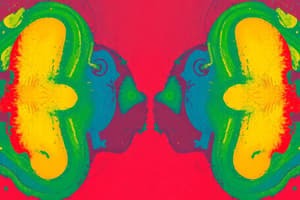Podcast
Questions and Answers
What is the definition of response-reinforcer contingency?
What is the definition of response-reinforcer contingency?
- A type of behavior governed by unconscious processes.
- A relationship in which a consequence (reinforcer) is delivered if and only if the target response occurs. (correct)
- A behavioral approach without any learned rules.
- A relationship where reinforcement is independent of the response.
What does rule-governed behavior refer to?
What does rule-governed behavior refer to?
Instructed behavior or behavior which conforms to a previously learned (verbal) rule.
What does S∆ represent?
What does S∆ represent?
A discriminative stimulus that suppresses instrumental responding because it signals that reinforcement is not available.
Define satiation in behavioral terms.
Define satiation in behavioral terms.
What is schedule thinning?
What is schedule thinning?
What does SD stand for?
What does SD stand for?
What is self-injurious behavior?
What is self-injurious behavior?
What is meant by self-control in behavioral psychology?
What is meant by self-control in behavioral psychology?
Define self-stimulation.
Define self-stimulation.
What does ABA Reversal refer to?
What does ABA Reversal refer to?
What are adjunctive behaviors?
What are adjunctive behaviors?
What does analytical pragmatism emphasize?
What does analytical pragmatism emphasize?
What is an appetitive stimulus?
What is an appetitive stimulus?
Define applied behavior analysis.
Define applied behavior analysis.
What is aversion therapy?
What is aversion therapy?
What defines an aversive stimulus?
What defines an aversive stimulus?
What is backward chaining?
What is backward chaining?
What constitutes a baseline?
What constitutes a baseline?
Define behavior analysis.
Define behavior analysis.
What is behavior trapping?
What is behavior trapping?
What does behavioral medicine target?
What does behavioral medicine target?
What comprises a behavioral repertoire?
What comprises a behavioral repertoire?
Define belongingness in a behavioral context.
Define belongingness in a behavioral context.
What is a changing criterion research design?
What is a changing criterion research design?
What characterizes classical conditioning?
What characterizes classical conditioning?
What is a compound stimulus?
What is a compound stimulus?
What does concurrent behavioral contingency refer to?
What does concurrent behavioral contingency refer to?
Define conditioned emotional response.
Define conditioned emotional response.
What is a conditioned reinforcer?
What is a conditioned reinforcer?
What is the constructional approach to behavior change?
What is the constructional approach to behavior change?
What defines the context of behavior?
What defines the context of behavior?
What is a contingency trap?
What is a contingency trap?
What constitutes contingency-shaped behavior?
What constitutes contingency-shaped behavior?
Define continuous reinforcement.
Define continuous reinforcement.
What is correspondence training?
What is correspondence training?
What is a dependent variable?
What is a dependent variable?
Define deprivation in a behavioral context.
Define deprivation in a behavioral context.
What is differential reinforcement of high rates?
What is differential reinforcement of high rates?
What is differential reinforcement of incompatible behaviors?
What is differential reinforcement of incompatible behaviors?
Define differential reinforcement of low rates.
Define differential reinforcement of low rates.
What is differential reinforcement of other behaviors?
What is differential reinforcement of other behaviors?
What is a discrete trials procedure?
What is a discrete trials procedure?
Define discrimination in behavior analysis.
Define discrimination in behavior analysis.
What is displacement behavior?
What is displacement behavior?
What does echolalia refer to?
What does echolalia refer to?
What is errorless discrimination training?
What is errorless discrimination training?
What is an establishing operation?
What is an establishing operation?
What is experimental analysis of behavior?
What is experimental analysis of behavior?
Define extinction in behavior analysis.
Define extinction in behavior analysis.
What is an extinction burst?
What is an extinction burst?
What are extrinsic reinforcers?
What are extrinsic reinforcers?
What is fading in behavior modification?
What is fading in behavior modification?
Define fear hierarchy.
Define fear hierarchy.
What is flooding in behavioral therapy?
What is flooding in behavioral therapy?
What is fluency training?
What is fluency training?
What is forward chaining?
What is forward chaining?
What is functional behavior analysis?
What is functional behavior analysis?
What is a generalized reinforcer?
What is a generalized reinforcer?
What is habit reversal?
What is habit reversal?
What is habituation?
What is habituation?
What are hypothetical constructs?
What are hypothetical constructs?
What does in vitro desensitization involve?
What does in vitro desensitization involve?
What is in vivo desensitization?
What is in vivo desensitization?
What is the independent variable in an experiment?
What is the independent variable in an experiment?
What defines intermittent reinforcement?
What defines intermittent reinforcement?
What is interresponse time?
What is interresponse time?
What is intertrial interval?
What is intertrial interval?
What defines intrinsic reinforcers?
What defines intrinsic reinforcers?
What is Keller's Personalized System of Instruction?
What is Keller's Personalized System of Instruction?
What is the law of effect?
What is the law of effect?
What is learned helplessness effect?
What is learned helplessness effect?
Define learning.
Define learning.
What is a learning curve?
What is a learning curve?
What does mainstreaming refer to?
What does mainstreaming refer to?
What is mammaCare?
What is mammaCare?
What is multiple baseline across behaviors?
What is multiple baseline across behaviors?
Define multiple baseline across stimulus conditions.
Define multiple baseline across stimulus conditions.
What is multiple baseline across subjects?
What is multiple baseline across subjects?
What is negative reinforcement?
What is negative reinforcement?
What does negatively accelerating mean?
What does negatively accelerating mean?
What is negatively decelerating?
What is negatively decelerating?
What is observer drift?
What is observer drift?
What is operant conditioning?
What is operant conditioning?
What is overcorrection?
What is overcorrection?
What is partial-reinforcement extinction effect?
What is partial-reinforcement extinction effect?
Define passive avoidance.
Define passive avoidance.
What is a performance contract?
What is a performance contract?
What is pivotal response training?
What is pivotal response training?
What is positive reinforcement?
What is positive reinforcement?
What does positively accelerating mean?
What does positively accelerating mean?
What is positively decelerating?
What is positively decelerating?
What is the Premack principle?
What is the Premack principle?
Define private behavior.
Define private behavior.
What does prompting entail?
What does prompting entail?
What is a reinforcer?
What is a reinforcer?
What is response blocking?
What is response blocking?
What is a response chain?
What is a response chain?
Define response class.
Define response class.
What is response cost?
What is response cost?
What is response latency?
What is response latency?
Flashcards are hidden until you start studying
Study Notes
ABA Terms Overview
- ABA Reversal: A research design comparing baseline (A) and treatment (B) phases to determine treatment effects through alternating conditions.
- Adjunctive Behavior: Excessive actions occurring between trials or reinforcers, potentially arbitrary in nature.
- Analytical Pragmatism: Emphasizes practical behavioral assessment and analysis methods to inform interventions.
- Appetitive Stimulus: Stimuli that are inherently rewarding and reinforce behavior positively.
- Applied Behavior Analysis: The practical application of behavioral principles to solve real-world problems.
- Aversion Therapy: A treatment method pairing inappropriate behaviors with unpleasant stimuli to create negative responses.
Behavior Conditioning Principles
- Aversive Stimulus: An unpleasant or noxious stimulus used in behavior modification.
- Backward Chaining: Training method where the last step of a behavior sequence is taught first, building backward through the steps.
- Baseline: The initial rate of behavior prior to any intervention, used for comparison.
- Behavior Analysis: Investigates the principles governing behavior by breaking down complex behavior-environment interactions.
- Behavior Trapping: Teaching behaviors that are maintained through natural reinforcements in the environment.
Behavioral Interventions
- Behavioral Medicine: Focuses on changing health-related behaviors, including compliance and lifestyle changes.
- Behavioral Repertoire: The complete range of behaviors an organism is capable of exhibiting.
- Changing Criterion Design: A research approach where the target behavior rate is gradually altered to assess changes over time.
- Classical Conditioning: Learning process where a neutral stimulus begins to elicit a conditioned response through association with an unconditioned stimulus.
- Compound Stimulus: A stimulus consisting of multiple components influencing response.
Response Dynamics
- Concurrent Behavioral Contingency: Multiple reinforcement contingencies operating simultaneously affecting behavior.
- Conditioned Emotional Response: A previously neutral stimulus evoking emotional responses after association with an aversive stimulus.
- Conditioned Reinforcer: A stimulus that gains reinforcement capability through its association with primary reinforcers.
- Constructional Approach: Focuses on skill-building to replace inappropriate behavior with appropriate alternatives.
Behavioral Context and Design
- Context of Behavior: The combination of an organism’s history and the environmental stimuli present during learning.
- Contingency Trap: A situation where unwanted behaviors are inadvertently reinforced, complicating behavioral interventions.
- Contingency-Shaped Behavior: Behavior directly controlled by reinforcing contingencies rather than rules.
- Continuous Reinforcement: Reinforcing every instance of a target response to establish behavior.
Learning Processes
- Correspondence Training: Training method to align verbal commitments with actual behaviors to enhance accountability.
- Dependent Variable: The measured outcome in behavior analysis, primarily focusing on participant behavior.
- Deprivation: Limiting access to a reinforcing stimulus to enhance its value as a reinforcer.
- Differential Reinforcement: Reinforcement strategies aimed at increasing appropriate behaviors or decreasing unwanted ones.
Experimental and Applied Techniques
- Discrete Trials Procedure: Isolates a specific behavior for focused teaching through repeated trials with reinforcement.
- Discrimination: Differentiating between stimuli based on relevant characteristics.
- Errorless Discrimination Training: A method minimizing errors during learning by gradually introducing signals.
- Establishing Operation: Changes to the environment that affect stimulus effectiveness as a reinforcer.
Advanced Concepts in ABA
- Experimental Analysis of Behavior: In-depth examination of behavior using systematic methods to identify controlling variables.
- Extinction: Diminishing a behavior by withholding reinforcement previously associated with it.
- Fluency Training: A method to improve the speed and accuracy of responses using a changing criterion method.
- Functional Behavior Analysis: Analyzes target behavior antecedents and consequences to identify their function.
Miscellaneous Terms
- Generalized Reinforcer: A secondary reinforcer linked to multiple primary reinforcers, enhancing its effectiveness.
- Habituation: Decreased response to a stimulus after repeated exposure.
- Intermittent Reinforcement: Reinforcing responses on a less than continuous schedule, promoting persistence.
- Negative Reinforcement: Increases behavior through the removal of an aversive stimulus.
Behavior Modification Strategies
- Overcorrection: Entails requiring subjects to engage in incompatible behaviors to correct unwanted behaviors.
- Prompting: Utilizing additional cues or stimuli to elicit a desired response and establish control.
- Response Cost: Decreases behavior through the removal of a positive reinforcer following unwanted behavior.
- Self-Injurious Behavior: Harmful behaviors directed towards oneself, indicating a need for behavioral intervention.
Summary of Learning Behaviors
- Positive Reinforcement: Increases behavior by presenting a wanted stimulus following a response.
- Premack Principle: Leveraging more preferred behaviors to enhance likelihood of less preferred behaviors occurring.
- Satiation: Diminished effectiveness of a stimulus as a reinforcer due to frequent exposure.
- Self-Control: The ability to wait for a more substantial reward rather than opting for an immediate, smaller one.
Studying That Suits You
Use AI to generate personalized quizzes and flashcards to suit your learning preferences.




